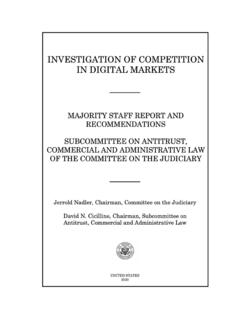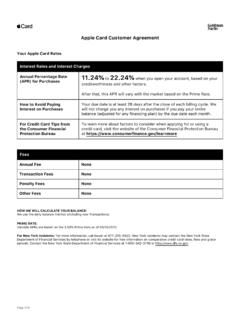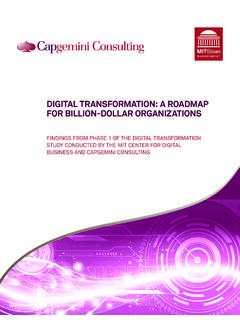Transcription of Digital Banking Benchmark - Deloitte
1 Deloitte Luxembourg Digital Banking BenchmarkImproving the Digital performance2 3 Executive summary 4 Quick overview of the performance and identified weaknesses of retail banks 6 Constantly changing operating conditions 8 Eight dimensions of the customer journey 10 Web Banking 12 Mobile Banking 22 Example of a fully Digital bank 26 Conclusion 28 ContentsThe information/data contained herein is based on the circumstances at the date of the document, in the specific jurisdiction as analysed by Deloitte on a best endeavours basis and is therefore subject to change at any time.
2 Deloitte has therefore no responsibility to nor will consider the impact of any events or circumstances between the time of analysis of the information/data and the time of publication of this summaryThree billion is the forecasted number of global users that will have access to retail Banking services through smartphones, tablets, PCs, and smartwatches by Digital revolution is disrupting the relationship between banks and their clients and new features continuously appear to enhance customer experience. However, Luxembourg banks do not seem to have implemented tremendous improvements in terms of Digital channels over the past two years. In an environment composed of fully- Digital banks, FinTechs, and non-traditional competitors, banks struggle to deliver innovative functionalities and are still hesitating about the key priorities to banks still offer significant room for improvement in terms of automation and online assistance. If they offer good features regarding design and ergonomics that also fulfil basic requirements, common features in the new Digital era could still be implemented.
3 Money management tools, automated customized advice, and robo-advisory are some of the trends banks may embrace to move away from competitors. Increasing online services ensure higher efficiency and better customer experience. The Deloitte Digital Banking Benchmark 2017 offers a multi-dimensional analysis with a current picture of the Luxembourg Digital Banking market for retail clients, a view on the improvements carried out over the past two years, and a comparison with banks from neighboring countries. Additionally, some insights are provided regarding the new trends that could enter the Luxembourg market in the coming 230 criteria regarding public websites, web Banking , and mobile applications of around 10 Luxembourg banks, this study will provide banks with a better understanding of their performance around eight key dimensions: Onboarding (automation and user-friendliness of the process) Content and functionalities (basic and value-added functionalities offered) Design and ergonomics (device compatibility and possible customization) Navigation (search tools and ease to find the required information) Cybersecurity features (assessment of some key elements) Advice (level of general and customized advice provided) Credit (possibility to make a demand and management of pending credits) Account closing (attempts to retain the client and understand the closure)Just like in the Digital Benchmark 2015, three types of Digital performers have been identified in Luxembourg.
4 The Luxembourg leaders, the medium performers, and the sub-performers. The total difference of points obtained between leaders medium performers and medium performers sub-performers is symmetric, but there are inequalities within the dimension Digital Banking users to reach nearly 3 billion by 2021, Voicendata, 2017 5 The Luxembourg leadersThis group offers the strongest national performance. Luxembourg leaders differentiate from other categories mainly thanks to their more developed onboarding process, their better functionalities offered in account management ( , card management; possibility to open various types of accounts) and their improved design and ergonomics. In terms of mobile Banking , leaders deliver a better performance regarding content and functionalities. On the other hand, national leaders deliver weak performances in terms of advisory and credit services, and still lack automated and deeply customized features in comparison to foreign markets. Taking inspiration from outside Luxembourg s borders would allow them to reinforce their position and gain a new competitive medium performersThese banks deliver satisfying services regarding daily account management and aim at challenging the leaders in terms of credit features and design and ergonomics.
5 However, some measures should be taken to reach the upper category. These banks should take advantage of the opportunities presented by initiatives such as PSD2 and the SEPA instant credit initiative to develop innovative features including money management tools (the possibility to set up a custom budget or saving goals, or a wider offering of languages available on their website). Additionally, their navigation functionalities are one step behind the leader category. These banks could potentially be rapidly outdated in the near future if they do not develop more automated and customer-centered functionalities. The sub-performersThis group does not fulfil some of the basic requirements from a customer perspective in terms of Digital performance. The content and functionalities offered barely fulfill the needs of clients in their everyday account management. As examples, these banks do not enable starting an online onboarding or booking an in-branch appointment online. Important Digital investments have to be carried out to reach the upper category and the Digital offer has to be included in the banks' results of the Benchmark highlight that even if leaders offer the best general performance, they still have room for improvement in certain dimensions to break away from the other categories.
6 Additionally, it demonstrates that the medium and sub-performers have to relativize their ranking by the dimensions assessed to understand their strengths and weaknesses. The Digital Banking Benchmark 2017 concludes its assessment with a prospective thought on the tactical and strategic adjustments banks should implement in order to face the upcoming changes that will affect them at an individual and industry level within the coming overview of the performance and identified weaknesses of retail banksAs in the 2015 edition of this Digital Banking Benchmark , we identify five main tactical areas for development. Retail banks in Luxembourg should work on and invest in these points in order to provide stronger online services and take advantage of a strongly- built Digital channel strategy: Increasing online services ensure higher efficiency and better customer experience. 04 701. Automated account opening and credit demand Facilitating users to upload required documentation would free bank resources for more value-added tasks.
7 It would also improve customer satisfaction by allowing them to carry out actions without having to visit a branch. This replies to a growing need for customer empowerment. 02. Implementation of advice features Regarding the profile of each user and their historical data, implementing advice functionalities would enable users to achieve their goals in terms of savings, returns, or investments. The use of analytics and a robo-adviser could be tracks to follow. 03. Development of smart money management tools The current offering is basic, and clients will increasingly require tools that automatically analyze and categorize the account movements. Forecasting tools that estimate the upcoming incomes and expenses based on client data facilitate account management and enhance customer experience as well as reduce costs for banks. 04. Customization of the services and constant assistance A deep profiling of clients, for instance through questionnaires and the use of analytics on historically collected data, has to be utilized to offer services and products that fit clients individual needs.
8 Moreover, a constant assistance (phone call, traditional chat, chatbot) should be developed as a matter of dedication to the users. 05. Improving the coverage of cybersecurity features without impairing user experience While the cybersecurity features benchmarked for web Banking are implemented for most of the banks with minor differences, there is more room for improvement to extend cybersecurity capabilities for mobile Banking applications. This can partly be explained by the greater maturity of web-based applications and the longer presence of regulatory requirements applicable to web Banking . The concern for cybersecurity aspects is real, as shown by the results of the Deloitte Global Mobile Consumer Survey 2016 where 29 percent of the respondents in Europe indicated they do not use their phone to make payments in-store for security changingoperating conditionsThe Digital revolution of the 21st century is reshaping the customer relationship with the banks. People of all ages are now connected 24/7 to their financial data, and millennials, the internet-born generation, require new services to satisfy their requirements in terms of customer experience.
9 Non-traditional competitors enter the Banking market prepared to satisfy those needs. FinTechs, with their light structures and young brand image, focus on cutting-edge services not covered by banks, or they provide existing services in a better way. New regulations appear in order to protect customers and to formalize the use of new technologies. Furthermore, the uncommon employment structure of Luxembourg exposes the local retail banks to a threat from border countries and creates country-specific needs. To face those trends, Luxembourg banks need to offer optimized Digital performance. A Deloitte survey carried out over 31 countries states that 94 percent of people between 18 and 75 years old have access to a computer and 88 percent have access to a Digital natives invading the labor market and the global emergence of internet technologies induces a lever effect difficult to forecast for The leading banks globally are among the ten-least-loved brands by millennials, and 33 percent of them believe they will not need a bank at all in the new generation is not as linked to their bank as the previous one and is ready to switch if a better offer is available elsewhere (better product, pricing, service, or Digital offer).
10 Contrary to the last decades, instantaneous accessibility to Banking services through Digital channels has increased interactions with clients. The frequency of moments of truth is higher, and banks should be able to meet the users needs with top-notch management tools and virtual disruption of new entrants leads to a new kind of competitionFinTechs, with flexible structures and lower costs, develop at a high speed and focus on niche markets where banks do not offer services or are performing poorly. Digicash, Paypal, and Kickstarter are examples of FinTechs experiencing success with online Banking services. Non-traditional new competitors, particularly retail companies, enter the Banking market with deep technological knowledge and abundant data on customer behavior. Benefiting from a positive image among new generations, these companies revolutionize the Digital experience regarding financial services and challenge traditional Banking strongholds and revenue sources. A majority of millennials (73 percent) would be more excited about a new offering in financial services from companies such as Google, Amazon, or apple rather than from their own nationwide regulations constrain banks to adapt their Digital offerings, widening the competition from new playersBanking regulations constantly arise and increasingly cover online services.














